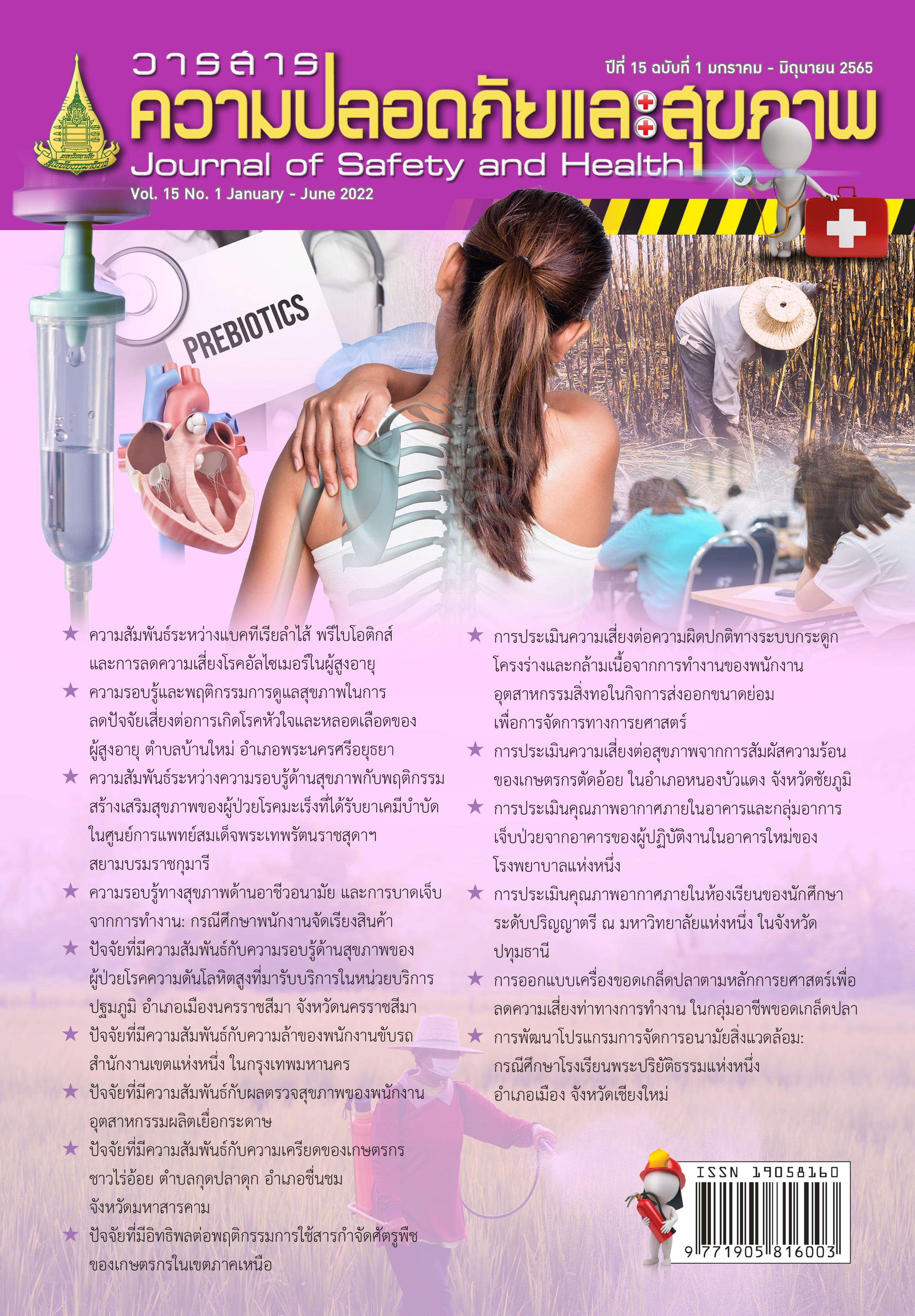Ergonomic Design of Automatic Fish Scale Remover to Reduce Working Posture Risk among Fish Scale Removing Workers.
Main Article Content
Abstract
The purposes of this quasi-experimental research were to: (1) assess the fatigue of the fish scale removing workers on parts of the body; (2) assess the level of ergonomic risk ; and (3) ergonomically design automatic fish scale remover to reduce working posture risk. A total of 16 samples was from 5 fish stores. Body part discomfort form, Rapid Entire Body Assessment (REBA) form were used as a major tool for the ergonomic designing automatic fish scale remover to reduce work posture risk and body proportions design by Pheasant S.T. (1982) method. Results demonstrated that:(1) the most fatigable part on the left-side body was neck (56.25%)-upper back (50.00%), lower back (50.00%), hand and wrist (50.00%), respectively. The most fatigable part on the right-side body was the upper arm (75.00%)-lower arm (62.50%), and neck (56.25%), respectively; (2) the ergonomic risk assessment using the REBA method on both the left and the right sides had a high risk (56.25%); and (3) after ergonomically designing the modified-automatic fish scale remover, the results showed that the level of fatigue of both on the left and right was lower, and on the left-side, the risks were reduced to low risk (62.50%), on the right-side, the risks were reduced to medium risk (100%).
Article Details

This work is licensed under a Creative Commons Attribution-NonCommercial-NoDerivatives 4.0 International License.
Journal of Safety and Health is licensed under a Creative Commons Attribution-NonCommercial-NoDerivatives 4.0 International (CC BY-NC-ND 4.0) licence, unless otherwise stated.
References
กองโรคจากการประกอบอาชีพและสิ่งแวดล้อม กรมควบคุมโรค. (2562). รายงานและสถานการณ์โรคและภัยสุขภาพจากการประกอบอาชีพและสิ่งแวดล้อม ปี 2561. นนทบุรี.
เกวลิน หนูฤทธิ์.(2563). สถานการณ์การผลิตและการค้าปลานิลและผลิตภัณฑ์ในช่วง 3 เดือนแรก ปี 2563. สืบค้นเมื่อ 29 มกราคม 2564, จาก https://www4.fisheries.go.th/local/pic_activities/ 202005190832332_pic.pdf
อรุณีย์ พรหมศรี. (2560). การประเมินท่าทางการทำงานและความผิดปกติของกระดูกและกล้ามเนื้อในช่างทำไม้กวาดดอกแก้ว. วารสารการประชุมวิชาการและนำเสนอผลงานวิจัยระดับชาติและระดับนานาชาติ ครั้งที่ 6, 452-463.
พงศกร สุรินทร์, มนินทรา ใจคำปัน, กิตติพงษ์ ประสงค์การ, วุฒิไกร กันทะหมื่น, และอจลวิชญ์ แสนป่ง. (2559). การประเมินปัจจัยเสี่ยงท่าทางการทำงานในกระบวนการผลิตเส้นขนมจีน. วารสารวิชาการอคณะเทคโนโลยีอุตสาหกรรม มหาลัยราชภัฎลำปาง, 9(2),59-70.
วีรชัย มัฎฐารักษ์. (2554). การประเมินภาวะทางการยศาสตร์ของเกษตรกรชาวสวนยางพาราที่นวดยางแผ่นด้วยแรงงานคน และเครื่องนวดยางแผ่น. วารสารวิชาการมหาวิทยาลัยราชภัฏสงขลา, 4(1), 654-663.
จีรนันท์ ธีระธารินพงศ์, และวีระพร ศุทธากรณ์. (2557). ความชุกของกลุ่มอาการผิดปกติทางระบบโครงร่าง กล้ามเนื้อและปัจจัยด้านท่าทางการทำงานในกลุ่มอาชีพสานตะกร้าไม้ไผ่.Thai Journal of Public Health, 44(3), 273-287.
สุนิสา ชายเกลี้ยง, และธัญญาวัฒน์ หอมสมบัติ. (2554). การประเมินความเสี่ยงทางการยศาสตร์การทำงานโดยมาตรฐาน RULA ในกลุ่มแรงงานทำไม้กวาดร่มสุข. ศรีนครินทร์เวชสาร, 26(1),35-40.
ยุวดี จอมพิทักษ์, และสายใจ พินิจเวชการ. (2560). การประเมินความเสี่ยงด้านการยศาสตร์ในสถานที่ทำงานของผู้ปฏิบัติงานกับคอมพิวเตอร์. มหาวิทยาลัยกรุงเทพธนบุรี.
สำนักโรคจากการประกอบอาชีพและสิ่งแวดล้อม กรมควบคุมโรค. (ม.ป.ป.). รายงานสถานการณ์โรคและภัยสุขภาพจากการประกอบอาชีพและสิ่งแวดล้อม ปี 2561 : โรคกระดูกและกล้ามเนื้อ. สืบค้นเมื่อ 29 มกราคม 2564, จาก http://envocc.ddc.moph.go.th
สมาคมการยศาสตร์ไทย. (2557). หลักการประเมินด้านการยศาสตร์ (Ergonomics assessment) (ออนไลน์). สืบค้นเมื่อ 29 มกราคม 2564, จาก http://1ab.in/skk
ปวีณา มีประดิษฐ์. (2559). การประเมินความเสี่ยงทางด้านการยศาสตร์. กรุงเทพฯ: โอ.เอส. พริ้นติ้งเฮ้าส์.
อนุวัฒน์ อัคคีสุวรรณ์, นุจรีย์ แซ่จิว, จำนงค์ ธนะภพ, และจันจิรา มหาบุญ. (2558). การบาดเจ็บและอาการทางระบบโครงร่างกล้ามเนื้อและกระดูกอันเนื่องมาจากการทำงานของเกษตรกรผู้ ประกอบอาชีพสวนปาล์ม เขตพื้นที่ตำบลสินปุน อำเภอเขาพนม จังหวัดกระบี่. วารสารความปลอดภัย และสุขภาพ, 8(29), 48-58.
อมฤทธิ์ จันทนาลาช, ชุติกาญจน์ ดาวเรือง, มงคล อุตญะถิน, และสุพัตรา โพธิ์ศรี. (2562). การประเมินความเสี่ยงด้านการยศาสตร์และความเมื่อยล้าจากการทำงานของคนรับเหมาตกแต่งภายใน กรณีศึกษา โรงพยาบาลศรีษะเกษ. วารสารวิชาการเฉลิมกาญจนา, 6 (2), 236-243.
Nilesh, N., Tanbir, Govind, B., Yenge, and Singh, A. (2017). Design, Development and Performance Evaluation of Fish Descaling Machine. Retrieved October 3, 2020,
Kumar, P., Chakrabarti, D., Patel, T., and Chowdhuri, A. (2016). Work-related pains among the workers associated with pineapple peeling in small fruit processing units of North East India. International Journal of Industrial Ergonomics., 124-129.
Hignett, S., & McAtamney, L. (2000). Rapid entire body assessment (REBA). Applied ergonomics, 31(2), 201-205.
Cameron, J. A. (1996). Assessing work-related body-part discomfort: current strategies and a behaviorally oriented assessment tool. International Journal of Industrial Ergonomics, 18(5-6), 389-398
Corlett, E. N., & Bishop, R. P. (1976). A technique for assessing postural discomfort. Ergonomics, 19(2), 175-182.
Pheasant, S. T. (1982). Anthropometric estimates for British civilian adults. Ergonomics, 25(11), 993-1001.
Abd Rahman, M. K. F., Shahriman, A. B., Desa, H., Daud, R., Razlan, Z. M., Khairunizam, W. A. N., ... & Afendi, M. (2015). Comparative study of Rapid Upper Limb Assessment (RULA) and Rapid Entire Body Assessment (REBA) between conventional and machine assisted napier grass harvest works. Applied Mechanics and Materials (786), pp. 275-280. Trans Tech Publications Ltd.
Ansari, N. A., & Sheikh, M. J. (2014). Evaluation of work Posture by RULA and REBA: A Case Study. IOSR Journal of Mechanical and Civil Engineering, 11(4), 18-23.


